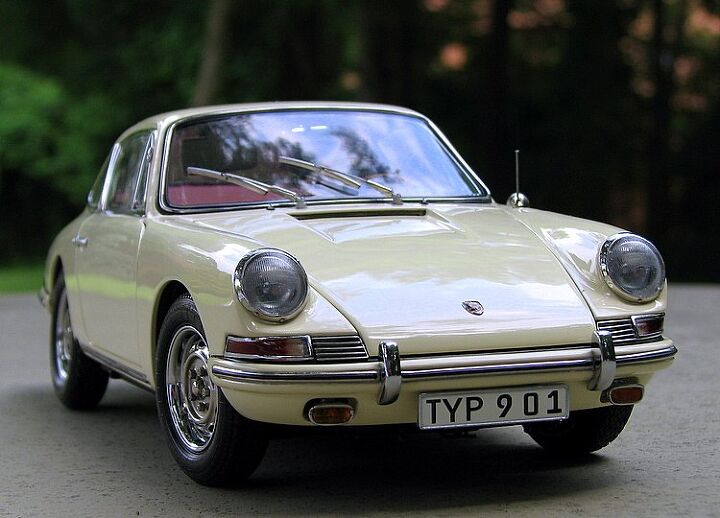WSJ: Porsches Are Too Difficult For Celebrities To Drive

Remember Nikki Catsouras? Possibly not. The young lady borrowed her father’s 911 Cabriolet, made a mistake at speeds reported to be in excess of 100 miles per hour, and was killed in a remarkably bloody and graphic fashion by the blunt end of a tollbooth.
Remember Chris Brown? The singer and occasional girlfriend-beater mildly crinkled the nose of his 911 Turbo S Cabriolet while ostensibly avoiding a squad of photographers.
Ever think those two incidents might be related?
This week, the Wall Street Journal opined that Porsches might, you know, just be too dangerous and/or difficult for unskilled operators to take to the proverbial eleventh tenth.
“Porsche’s (sic) are known for this quality that driving experts call “oversteer.” It has been a contributing factor in some crashes, though Porsche said it has tamed the tendency through numerous design and engineering changes over the 50 years the model has been on the market. However, the car’s handling makes it especially nimble and extremely fast in skilled hands… In fast corners, the relatively heavy rear-mounted engine can act a bit like the head of a hammer. It seems to want to swing around toward the outside of the turn. Well-trained drivers know it’s vital to continue applying power, making subtle adjustments to keep the car balanced and under control.”
I’m not sure that any “well-trained” 911 driver in history has ever considered the car to be particularly nimble, unless one’s standard of comparison is a Ninety-Eight Regency Brougham. Nor would it necessarily be a good idea to just KEEP THE POWER ON! at all times if one’s 911 is out of control. In the modern cars, the best thing to do is to press strongly on the brake and let the PSM sort things out.
In truth, the current 911 is almost impossible to get out of shape, something I confirmed for myself during some recent track time in the 991 Carrera S PDK. The car’s default behavior is stability, and that’s exacerbated by the massive discrepancy between front and rear tire size. If anything, it’s considerably safer to drive than the high-power AMG Benzes and over-turbocharged current crop of BMW M cars, all of which are capable of swapping ends pretty quickly if the traction control is disabled. Even the current Corvette can be considerably more vicious than any water-pumper 911.
Porsche spokesperson Nick Twork responded to the WSJ’s questions regarding Porsche safety in remarkably ambiguous terms:
Porsche spokesman Nick Twork said while the cars require “slightly different driving techniques,” they are “as safe as any other cars on the road…. You have to think about what you are doing when you drive them… You have to be careful.”
In Mr. Twork’s shoes, I might have been considerably more emphatic about the remarkable safety and docility of Porsche’s current products, but I can understand why he wasn’t. Fifty years ago, the company took half-measures like bolting lead weights on the 911’s front bumper and cheerfully looked the other way as the new rich of the Western world backed their products into trees at high speed with depressing regularity. The 911’s resulting reputation as a challenging car to drive probably sold a lot more buyers than it discouraged, particularly as the cars became more and more docile in real-world use. The legend of the unstable 911 became an essential part of the car’s appeal, so much so that outstanding products like the 944 Turbo and 928 were often the subject of frank criticism for being “easy to drive”.
In 2013, the 911 Carrera is easy as pie to drive fast, but nobody at Porsche is eager to trumpet that fact from the mountaintops, any more than they are in a hurry to explain to their customers why the 911 costs more than the Cayman and the Cayman costs more than the Boxster. The WSJ article is, effectively, a sales tool. It allows the investment bankers of suburban Chicago to intone, “Well, this is the car Chris Brown crashed… it was too much for him. They aren’t for everyone. Of course, I’ve never had any problem with mine.”
The WSJ does note that
“Road accidents tend to happen to drivers who lack the skills needed to drive some Porsche models smoothly and safely at high speed.”
The same thing is true for Civics, of course. Why isn’t Chris Brown crashing Civics? Perhaps when his money runs out, he’ll get the chance.

More by Jack Baruth
Latest Car Reviews
Read moreLatest Product Reviews
Read moreRecent Comments
- Peter I want a self driving red ragtop 1958 Plymouth Fury. Just like the car in the movie Christine.
- Mgh57 Doesn't seem like this tech is ready for prime time.
- Nathan The Ram is the most boring looking of the full size trucks, kind of like a Tundra.If they cancel the Ram Classic, I hope a full resign makes the Ram at least look interesting.
- DJB1 I'll be all for it when it has a proven safety record. I have an awesome life and a lot to live for, so right now I'm not putting that in the hands of overconfident tech-bros.
- Mgh57 I had to read the article because I had had no idea what the headline meant. I've never seen this in the Northeast. Don't understand the point. Doesn't seen efficient aerodynamically


































Comments
Join the conversation
To paraphrase Mr. Nader, some people are dumbasses at any speed. Money and a fast car doesn't change the dumbass to weight ratio.
Images show Chris Brown's Porsche did NOT "leave the road back-asswards." Anecdotal evidence in WSJ equals fail. I'd assume a slow news day. Perhaps it's modern tires or newer Bilsteins, but my old 74 911 has no more tendency to oversteer than my first car - a 73 Camaro. People should actually drive a car before believing in legend.